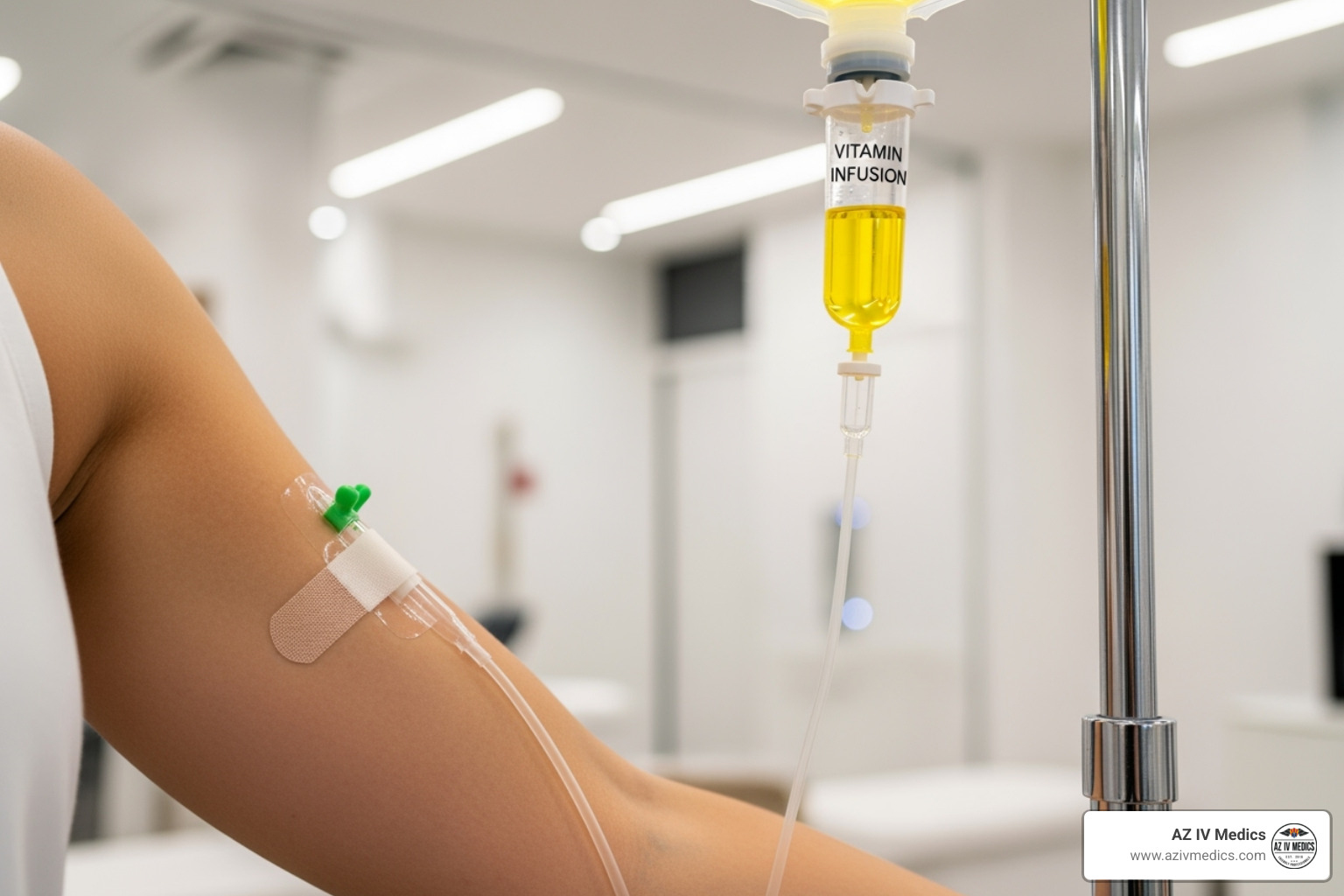How to Rehydrate After Vomiting: Tips for Quick Recovery
Joseph Lopez • May 23, 2023

Throwing up is never fun, but sometimes it's necessary to rid our bodies of harmful toxins or illness. However, vomiting can lead to dehydration, which can leave you feeling fatigued, dizzy, and can even lead to more serious health issues. In this article, we'll look at the best ways to rehydrate after vomiting and how to prevent dehydration in the future.
Understanding Dehydration After Vomiting
Vomiting causes a significant loss of fluid in our bodies, leading to dehydration. When our body loses too much water and electrolytes, it can leave us feeling extremely weak and lethargic. In severe cases, dehydration can lead to more serious medical conditions such as heat exhaustion or kidney damage.
Dehydration is a condition that occurs when the body loses more water than it takes in. When we lose too much water, our body is unable to function properly. This can lead to a range of symptoms, including dry mouth, dark yellow urine, fatigue, dizziness, and confusion.
Causes of Dehydration
Dehydration is primarily caused by the loss of fluids and electrolytes in the body. When we vomit, we lose both fluids and electrolytes, which can cause dehydration. Other causes of dehydration include sweating, diarrhea, and fever.
It's important to note that certain medications can also cause dehydration. For example, diuretics, which are often used to treat high blood pressure, can cause the body to lose fluids and electrolytes.
Signs and Symptoms of Dehydration
Some common signs and symptoms of dehydration include feeling thirsty, dry mouth, dark yellow urine, fatigue, dizziness, and confusion. In addition to these symptoms, severe dehydration can also cause a rapid heartbeat, sunken eyes, and dry skin.
If you experience any of these symptoms, it's important to take immediate steps to rehydrate your body. Drinking water or electrolyte-rich fluids can help replenish lost fluids and prevent further dehydration.
Risks Associated with Dehydration
Dehydration can lead to several health risks, including kidney damage, heat exhaustion, seizures, and coma. It's important to take dehydration seriously and take the necessary steps to prevent it from occurring.
In addition to drinking plenty of fluids, it's important to avoid activities that can cause excessive sweating, such as exercising in hot weather. If you are experiencing symptoms of dehydration, it's also important to seek medical attention immediately.
Dehydration can be a serious condition, but with proper hydration and care, it can be easily prevented and treated.
Immediate Steps to Take After Vomiting
Experiencing vomiting can be a distressing experience, but it is essential to take immediate steps to rehydrate your body. Dehydration can occur quickly, so it's important to act fast. Here are some additional steps you can take to help you recover from vomiting:
Rest and Relax
After vomiting, it's important to allow your body to rest and recover. Resting can help you to regain your strength and energy, and it can also help to reduce any feelings of nausea or dizziness. It's essential to avoid any strenuous activity until you are feeling better, as this can further upset your stomach.
Try to take it easy for a few hours or even a day if needed. You can take this time to catch up on some much-needed sleep, read a book, or watch your favorite movie. Remember that your body needs time to heal, so be patient and take it slow.
Take Small Sips of Water
One of the most effective ways to rehydrate your body after vomiting is to sip small amounts of water throughout the day. It's essential to start with a few sips of water and gradually increase the amount as your body starts to tolerate it. Avoid gulping large amounts of water as it can further upset your stomach.
You can also try drinking clear fluids like coconut water, sports drinks, or clear broths. These fluids can help to replenish the electrolytes lost during vomiting and can help you to feel better faster.
Avoid Certain Foods and Drinks
When rehydrating, it's important to avoid foods and drinks that can make dehydration worse. These include sugary drinks, caffeine, and alcohol, which can increase dehydration and make you feel worse.
You should also avoid eating heavy or spicy foods, as these can irritate your stomach and make you feel nauseous. Instead, try eating small, frequent meals of bland foods like crackers, toast, or rice. These foods are gentle on your stomach and can help to ease any feelings of nausea.
Remember that vomiting can be a sign of an underlying health condition, so if you experience frequent or severe vomiting, it's essential to seek medical attention. Your healthcare provider can help to diagnose the cause of your vomiting and provide you with the necessary treatment.
Best Fluids for Rehydration
Dehydration can be caused by various factors such as excessive sweating, vomiting, diarrhea or even not drinking enough fluids. The symptoms of dehydration can include dry mouth, dizziness, headache, and fatigue. To rehydrate your body effectively, it's important to choose fluids that are high in electrolytes and hydration. Here are some of the best fluids for rehydration:
Water
Plain water is a great option for rehydration and replenishing lost fluids and electrolytes. It's best to drink small amounts of water gradually throughout the day instead of drinking large amounts at once. Drinking water can also help regulate body temperature and prevent constipation.
Oral Rehydration Solutions
If you're experiencing severe dehydration, you may need to use an oral rehydration solution such as Pedialyte or Gatorade. These solutions contain a perfect balance of electrolytes and fluids that can help rehydrate your body quickly. Oral rehydration solutions are especially useful for athletes or people who work out regularly as they tend to lose a lot of fluids and electrolytes through sweat.
Sports Drinks
Sports drinks such as Gatorade or Powerade are a good option for mild dehydration as they contain electrolytes and carbohydrates, which can help restore energy levels and rehydrate your body. These drinks are also a good option for people who are physically active as they can help replenish lost fluids and electrolytes during and after exercise.
Herbal Teas
Herbal teas such as ginger or chamomile tea can help soothe your stomach and replenish lost fluids if you're feeling nauseous. These teas also contain antioxidants that can help boost your immune system. Ginger tea, in particular, has anti-inflammatory properties that can help reduce muscle pain and soreness.
Clear Broths
Broths such as chicken or beef broth contain sodium and other electrolytes that can help rehydrate your body effectively. They're also easy to digest, making them a good option if you're feeling queasy. Clear broths are often recommended for people who are recovering from an illness or surgery as they can help boost the immune system and provide essential nutrients.
It's important to note that while these fluids can help rehydrate your body, they should not be used as a substitute for medical treatment if you're experiencing severe dehydration. If you're experiencing symptoms of severe dehydration such as rapid heartbeat, confusion, or difficulty breathing, seek medical attention immediately.
Gradually Reintroducing Foods
If your vomiting was caused by an illness or food poisoning, it's important to reintroduce foods gradually once you're feeling better. This will give your digestive system time to adjust and prevent any further discomfort. Here are some guidelines to follow:
The BRAT Diet
The BRAT diet consists of foods that are low in fiber and are easy to digest. These foods include bananas, rice, applesauce, and toast. These foods can help replenish lost nutrients and restore bowel movements. However, it's important to note that the BRAT diet should only be followed for a short period of time, as it lacks the necessary nutrients for long-term health.
Once you've been on the BRAT diet for a day or two, you can start incorporating other foods back into your diet. Start with small, bland meals such as boiled chicken, steamed vegetables, and plain pasta. These foods are easy to digest and won't upset your stomach.
Easy-to-Digest Foods
Soup, gelatin, and applesauce are all considered easy-to-digest foods that can help replenish nutrients after vomiting. These foods are also hydrating, which is important after experiencing vomiting or diarrhea. Additionally, you can try drinking clear fluids such as water, herbal tea, and sports drinks to help replenish lost fluids and electrolytes.
It's important to avoid caffeine and alcohol during this time, as they can dehydrate you and further upset your stomach.
Foods to Avoid During Recovery
During recovery, it's best to avoid foods that are high in fat and sugar, as well as spicy or greasy foods. These types of foods can cause further upset to your stomach and set back your recovery. Additionally, you should avoid dairy products for a few days, as they can be difficult to digest and may cause bloating and discomfort.
Instead, focus on nutrient-dense foods such as lean protein, whole grains, and fruits and vegetables. These foods will provide your body with the necessary nutrients to help you recover and get back to feeling your best.
Remember to listen to your body during this time and eat slowly and in small portions. If you experience any discomfort or nausea, take a break from eating and try again later.
By following these guidelines and gradually reintroducing foods, you can help your body recover from vomiting and get back to feeling your best.
Preventing Dehydration in the Future
Dehydration can be a serious health concern, but fortunately, it's also easily preventable. By taking some simple steps, you can ensure that your body stays properly hydrated and avoid the negative effects of dehydration.
Hydrate Regularly
One of the most important steps you can take to prevent dehydration is to drink plenty of fluids throughout the day. This is especially important when you're sweating or experiencing diarrhea, as these can both lead to significant fluid loss. To make sure you're hydrating regularly, carry a refillable water bottle with you wherever you go. This will make it easy to drink water throughout the day, even when you're on the go.
It's also important to remember that not all fluids are created equal. While water is the best choice for staying hydrated, other fluids like juice, tea, and sports drinks can also contribute to your fluid intake. Just be sure to avoid sugary drinks, as these can actually dehydrate you further.
Monitor Your Fluid Intake
In addition to staying hydrated throughout the day, it's important to pay attention to how much fluid you're consuming compared to how much you're losing. If you're sweating heavily or experiencing diarrhea, you may need to drink more fluids than usual to compensate for the additional fluid loss. You can monitor your fluid intake by keeping track of how much water you're drinking and how often you're urinating. If you notice that you're losing more fluids than you're taking in, it's time to drink more water.
Recognize Early Signs of Dehydration
Even if you're taking steps to stay hydrated, it's still possible to become dehydrated. That's why it's important to recognize the early signs of dehydration, such as feeling thirsty or fatigued. If you notice these symptoms, take immediate steps to rehydrate yourself. Drink plenty of water and other fluids, and consider taking a break from any physical activity you're doing until you start to feel better.
By following these simple steps, you can prevent dehydration and ensure that your body stays properly hydrated. Remember, staying hydrated is essential for your overall health and well-being, so make it a priority in your daily life.
When to Seek Medical Help
In some cases, vomiting and dehydration can require medical attention. Here are some signs that it's time to seek medical help:
Persistent Vomiting
If you're unable to keep fluids down or are experiencing persistent vomiting, seek medical attention immediately.
Persistent vomiting can be a sign of a more serious underlying condition, such as a stomach ulcer or appendicitis. It's important to seek medical attention to determine the underlying cause and receive appropriate treatment.
Severe Dehydration Symptoms
If you're experiencing severe dehydration symptoms such as confusion, rapid heartbeat, or difficulty breathing, seek medical attention immediately.
Severe dehydration can lead to serious complications, such as organ failure or seizures. It's important to seek medical attention to receive intravenous fluids and prevent further complications.
Underlying Medical Conditions
If you have an underlying medical condition such as diabetes or heart disease, dehydration can be especially dangerous. If you're experiencing symptoms of dehydration, it's important to seek medical attention immediately.
Dehydration can exacerbate underlying medical conditions and lead to serious complications. It's important to seek medical attention to receive appropriate treatment and prevent further health problems.
By following the tips in this article, you can effectively rehydrate your body after vomiting and prevent dehydration in the future. Remember to listen to your body and take the necessary steps to rehydrate when needed.
It's important to note that certain populations may be at a higher risk for dehydration and should take extra precautions. These populations include:
- Infants and young children
- Elderly individuals
- Individuals with chronic illnesses
- Athletes and individuals who engage in strenuous physical activity
If you fall into one of these categories, it's important to take extra care to stay hydrated and seek medical attention if you experience symptoms of dehydration.
In addition to drinking fluids, there are other steps you can take to prevent dehydration. These include:
- Eating water-rich foods such as fruits and vegetables
- Avoiding alcohol and caffeine, which can dehydrate the body
- Dressing appropriately for the weather to prevent excessive sweating
- Using a humidifier in dry environments
By taking these steps, you can help prevent dehydration and maintain optimal health.




